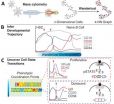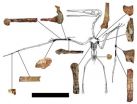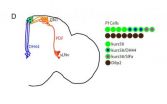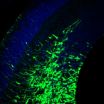(Press-News.org) New York, NY - In the April 24, 2014 edition of Cell, a team of researchers led by Dana Pe'er at Columbia University and Garry Nolan at Stanford University describes a powerful new method for mapping cellular development at the single cell level. By combining emerging technologies for studying single cells with a new, advanced computational algorithm, they have created the most comprehensive map ever made of human B cell development. Their approach will greatly improve researchers' ability to investigate development in cells of all types, make it possible to identify rare aberrations in development that lead to disease, and ultimately help to guide the next generation of research in regenerative medicine.
Discussing why having these kinds of maps is an important advance, Dr. Pe'er explains, "There are so many diseases that result from malfunctions in the molecular programs that control the development of our cell repertoire and so many rare, yet important, regulatory cell types that we have yet to discover. We can only truly understand what goes wrong in these diseases if we have a complete map of the progression in normal development. Such maps will also act as a compass for regenerative medicine, because it's very difficult to grow something if you don't know how it develops in nature. For the first time, our method makes it possible to build a high-resolution map, at the single cell level, that can guide these kinds of research."
Although conventional dogma characterizes development as a series of discrete steps, cells actually develop in a process of continuous transformation. As a cell matures, the complex and interconnected molecular programs that regulate its activity change gradually. These programs can also differ significantly among cells of similar type, and in many important regulatory cell types, rare aberrations in these programs can have devastating effects. Previously, it was difficult to observe these subtle differences in sufficient detail to distinguish them, but new technologies now offer important new opportunities.
Just as genome sequencing transformed how biology was studied in the previous decade, new technologies for analyzing the molecular properties of single cells are currently revolutionizing the kinds of questions many biologists are asking. Dr. Pe'er sees single-cell approaches as an important step beyond genomics. "DNA sequencing can identify genes and mutations, but often they are not studied in context," she points out. "With single-cell approaches, we can map the cells where the action actually happens and what the genes are doing inside them."
In the research described in the Cell paper, the investigators used an emerging technology called mass cytology, which in a single experiment can measure 44 molecular markers simultaneously in millions of individual cells. This provides a wealth of data that can be used to compare, categorize, and chronologically order cells, and makes it possible to begin identifying the molecular systems responsible for development in much greater detail than was ever before possible.
Taking advantage of this complex single-cell data also required the researchers to develop new mathematical and computational methods for interpreting it. Just as one can represent a physical object in three dimensions — length, width, and height — the Pe'er lab's approach involved thinking of the 44 measurements as a 44-dimensional geometric object. They then developed a new computational algorithm, called Wanderlust, which uses mathematical concepts from a field called graph theory to reduce this high-dimensional data into a simple form that is easier to interpret.
Such a high-dimensional geometry is impossible for us to visualize, and so Wanderlust converts the collection of measurements of important developmental markers in each cell into a single one-dimensional value that corresponds to the cell's place within the chronology of development. To properly put each cell in place, Wanderlust converts the high-dimensional geometry into a graph, where each individual cell is represented as a point that is connected by a line (also called an edge) to other cells that are most similar to it. Cells that are closest within the developmental trajectory appear close together on the graph, while those that are at different developmental stages appear farther away. By including all of the hundreds of thousands of cells that were profiled, this graph does not force cells into categories, but represents a continuous new geometry that captures the entire developmental trajectory.
According to Dr. Pe'er, "For years, mathematics has been used in physics to show that there are very elegant mathematical relationships that define the way the universe is structured. When looked at from the perspective of mathematics, we see that the complexity found in biology is also beautifully structured and patterned. Our body has trillions of cells of countless different types, each type bearing different molecular features and behavior. This complexity expands from a single cell in a carefully regulated process called development. This regulation creates patterns and shapes in the high-dimensional data we measure. By using Wanderlust to analyze these data we can find the pattern and trace the trajectory that cellular development follows."
To test their approach, the researchers studied development in human B cells, a type of cell that is important in the adaptive immune response and is involved in a variety of autoimmune diseases as well as certain types of cancer. Since immune cells continue to develop throughout adult life, even a single sample from one bone marrow contains cells from all stages of B-cell development. Investigators in the Nolan lab used mass cytometry to profile 44 markers in a cohort of approximately 200,000 healthy immune cells that were gathered from one such sample. In each cell they measured cell surface markers that help identify what type of cell it is, as well as markers inside the cell that can reveal what the cell is doing, including markers for signaling, the cell cycle, apoptosis, and genome rearrangement.
Using Wanderlust to analyze the high-dimensional data provided by mass cytometry, the researchers accurately ordered the entire trajectory of 200,000 cells according to their developmental chronology. In a strong indication of its accuracy, Wanderlust captured and correctly ordered all of the primary molecular landmarks known to be present in human B cell development. Wanderlust also pinpointed a number of previously unknown key regulatory signaling checkpoints that are required for human B cell development as well as uncharacterized subtypes of B cell progenitor cells that correspond to important developmental stages. This trajectory constitutes the most comprehensive analysis of human B cell development that has ever been conducted.
In a sign of the high degree of precision that Wanderlust offers for studying single cells, the researchers also report that they identified rare, previously unknown signaling events involving the signaling protein STAT5 that occurred in just 7 out of 10,000 cells. This regulatory event is involved in the process of VDJ recombination, a volatile time when the B-cell is reshuffling its own DNA. Further laboratory experiments showed that disrupting these signaling events using kinase inhibitors fully stalled the development of B cells.
Identifying and characterizing the regulatory checkpoints that control and monitor cell fate can have many practical applications, as many diseases result from imbalance in the cell types produced by the immune system. Thus, the approach that the authors describe can produce insights that could be used for the development of new diagnostics and therapeutics.
This process for mapping how healthy cells develop can be applied not just to B cells, but to any type of cell. As the authors suggest, their method offers the possibility of providing a foundation for studying normal development as well as the processes responsible for any kind of developmental disease. In the future, they anticipate that more sophisticated models could be built that would be capable of representing even more complex systems, such as the entire immune system. The holy grail would involve creating a complete map of every cell type in the body and how each progressively develops from a single stem cell, pinpointing every cell fate decision along the way.
Achieving this goal will require a lot more work, but as Dr. Pe'er points out, "This current project is a landmark both in the study of development and in single-cell research, and has completely changed the way I think about science. A fire has been lit, and these findings are just the tip of the iceberg of what is now possible."
INFORMATION: END
Researchers create comprehensive map of human B cell development
2014-04-24
ELSE PRESS RELEASES FROM THIS DATE:
Surprising new insights into the PTEN tumor suppressor gene
2014-04-24
BOSTON – Ever since it was first identified more than 15 years ago, the PTEN gene has been known to play an integral role in preventing the onset and progression of numerous cancers. Consequently, when PTEN is either lost or mutated, malignant cells can grow unchecked and cancer can develop.
Now a team led by investigators at Beth Israel Deaconess Medical Center (BIDMC) helps explain more precisely how PTEN exerts its anti-cancer effects and how its loss or alteration can set cells on a cancerous course. The new study, which reveals that PTEN loss and PTEN mutations are ...
Researchers pinpoint protein crucial for development of biological rhythms in mice
2014-04-24
Johns Hopkins researchers report that they have identified a protein essential to the formation of the tiny brain region in mice that coordinates sleep-wake cycles and other so-called circadian rhythms.
By disabling the gene for that key protein in test animals, the scientists were able to home in on the mechanism by which that brain region, known as the suprachiasmatic nucleus or SCN, becomes the body's master clock while the embryo is developing.
The results of their experiments, reported online April 24 in Cell Reports, are an important step toward understanding ...
Oldest pterodactyloid species discovered, named by international team of researchers
2014-04-24
WASHINGTON—An international research team, including a George Washington University (GW) professor, has discovered and named the earliest and most primitive pterodactyloid—a group of flying reptiles that would go on to become the largest known flying creatures to have ever existed—and established they flew above the earth some 163 million years ago, longer than previously known.
Working from a fossil discovered in northwest China, the project—led by University of South Florida (USF) paleontologist Brian Andres, James Clark of the GW Columbian College of Arts and Sciences ...
Fruit fly study identifies brain circuit that drives daily cycles of rest, activity
2014-04-24
PHILADELPHIA - Amita Sehgal, PhD, a professor of Neuroscience at the Perelman School of Medicine, University of Pennsylvania, describes in Cell a circuit in the brain of fruit flies that controls their daily, rhythmic behavior of rest and activity. The new study also found that the fly version of the human brain protein known as corticotrophin releasing factor (CRF) is a major coordinating molecule in this circuit. Fly CRF, called DH44, is required for rest/activity cycles and is produced in cells that receive input from the clock cells in the fly brain. In mammals, CRF ...
Scientists find way to target cells resistant to chemo
2014-04-24
Scientists from The University of Manchester have identified a way to sensitise cancer cells to chemotherapy - making them more open to treatment.
The study published today in Cell Reports, could pave the way for the development of drugs to target cells that have become resistant to treatment.
The research team made the discovery whilst exploring the possible mechanisms behind resistance to chemotherapy drugs like Paclitaxel, often used to treat breast and colon cancer.
Dr Andrew Gilmore, who led the research team at The University of Manchester, is part of both the ...
New type of protein action found to regulate development
2014-04-24
Johns Hopkins researchers report they have figured out how the aptly named protein Botch blocks the signaling protein called Notch, which helps regulate development. In a report on the discovery, to appear online April 24 in the journal Cell Reports, the scientists say they expect the work to lead to a better understanding of how a single protein, Notch, directs actions needed for the healthy development of organs as diverse as brains and kidneys.
The Johns Hopkins team says their experiments show that Botch uses a never-before-seen mechanism, replacing one chemical group ...
Researchers discover new genetic brain disorder in humans
2014-04-24
A newly identified genetic disorder associated with degeneration of the central and peripheral nervous systems in humans, along with the genetic cause, is reported in the April 24, 2014 issue of Cell.
The findings were generated by two independent but collaborative scientific teams, one based primarily at Baylor College of Medicine and the Austrian Academy of Sciences, the other at the University of California, San Diego School of Medicine, the Academic Medical Center (AMC) in the Netherlands and the Yale University School of Medicine.
By performing DNA sequencing ...
Scientists reprogram blood cells into blood stem cells in mice
2014-04-24
BOSTON (April 24, 2014)—Researchers at Boston Children's Hospital have reprogrammed mature blood cells from mice into blood-forming hematopoietic stem cells (HSCs), using a cocktail of eight genetic switches called transcription factors. The reprogrammed cells, which the researchers have dubbed induced HSCs (iHSCs), have the functional hallmarks of HSCs, are able to self-renew like HSCs, and can give rise to all of the cellular components of the blood like HSCs.
The findings mark a significant step toward one of the most sought-after goals of regenerative medicine: the ...
To mark territory or not to mark territory: Breaking the pheromone code
2014-04-24
LA JOLLA, CA— April 24, 2014 —A team led by scientists at The Scripps Research Institute (TSRI) has deciphered the surprisingly versatile code by which chemical cues help trigger some of the most basic behaviors in mice.
The findings shed light on the evolution of mammalian behaviors—which include human behaviors—and their underlying brain mechanisms.
"How does an individual respond differently to the environment based on experience? How does it distinguish itself from others? These are some of the fundamental questions that a study like this one helps us address," ...
Genetic legacy from the Ottoman Empire: Single mutation causes rare brain disorder
2014-04-24
An international team of researchers have identified a previously unknown neurodegenerative disorder and discovered it is caused by a single mutation in one individual born during the Ottoman Empire in Turkey about 16 generations ago.
The genetic cause of the rare disorder was discovered during a massive analysis of the individual genomes of thousands of Turkish children suffering from neurological disorders.
"The more we learn about basic mechanisms behind rare forms of neuro-degeneration, the more novel insights we can gain into more common diseases such as Alzheimer's ...






